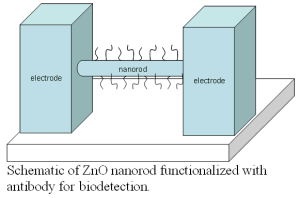Research Projects

ZnO Nanowire Nanosensors for Biodetection and Identification
R&D Team: Dr. David Norton1, Dr. Stephen Pearton1, Dr. Fan Ren2.
1Department of Materials Science and Engineering, 2Department of Chemical Engineering.
Opportunity and Impact: There is an urgent and also long-term need to develop improved compact, integrated sensors for biosensing applications. Development of the basic science of identifying chemical and biological agents will be the basis of this program. The ultimate target product will be a nanowire sensor for detection and quantified identification of biological molecules. Potential markets include medical assay and homeland security. The market for these monitoring devices will be in >$100M annually.
Project Description: Current approaches to biological molecule detection using optical methods often suffer from bleaching effects while electronic sensors such as Si-based transistor structures suffer from fundamental instability problems due to reaction with the ionic solutions endemic to bio-sensing. ZnO nanowires also offer many advantages over alternative strategies such as carbon nanotubes for sensing, including being chemically inert in most electrolyte solutions (low linear drift),the availability of heterostructures which greatly enhances sensitivity due to the presence of 2D carrier gases, transparency to wavelengths up to the UV and greater control of conductivity. The shift from thin film bio-sensors to nanowires will bring an approximate increase in detection sensitivity of almost three orders of magnitude (to the µg/ml range), based on a simple calculation for a wire of diameter 30 nm and length 5 µm relative to a gateless HEMT with gate area 0.5 µm x 5 µm.
 The focus of this proposal work is to explore the use chemically-functionalized ZnO nanowires in the detection and identification of biological pathogens. The mechanism for detection is the change in electrical conductance as chemical species absorb on the metal oxide surface. Identification of selected biomolecules will be possible via the adsorption of antibody groups on the ZnO surface that target specific molecules of interest. The high surface area to volume ratio of a free-standing nanowires is near-ideal for developing high sensitivity nano-sensors for gas- and/or bio-detection. ZnO nanowires will be synthesized with diameters as small as 15 nm and length greater than 1 µm. Conductance bridges will be fabricated using e-beam lithography. These structures, when functionalized with selective surface chemistry, are ideal for detection of molecular species based on changes in low dimensional transport. The large surface area to volume ratio in ZnO nanowires presents the possibility of detecting single molecules relevant to selected biological systems.
The focus of this proposal work is to explore the use chemically-functionalized ZnO nanowires in the detection and identification of biological pathogens. The mechanism for detection is the change in electrical conductance as chemical species absorb on the metal oxide surface. Identification of selected biomolecules will be possible via the adsorption of antibody groups on the ZnO surface that target specific molecules of interest. The high surface area to volume ratio of a free-standing nanowires is near-ideal for developing high sensitivity nano-sensors for gas- and/or bio-detection. ZnO nanowires will be synthesized with diameters as small as 15 nm and length greater than 1 µm. Conductance bridges will be fabricated using e-beam lithography. These structures, when functionalized with selective surface chemistry, are ideal for detection of molecular species based on changes in low dimensional transport. The large surface area to volume ratio in ZnO nanowires presents the possibility of detecting single molecules relevant to selected biological systems.
Research activities in the use of 1-D ZnO nanowires for detection of biological pathogens will focus on the following issues: 1) study the basic binding mechanism between peptides and ZnO based materials, including selection of peptides with semiconductor binding specificity, investigation of bonding of selected peptides and role of peptide sequence, and correlation of adsorbate bonding with semiconductor surface band bending, 2) synthesis of ZnO nanowires with various doping surface chemistry terminations, including n-type, p-type, and intrinsic nanowire synthesis, as well as ZnO, (Zn,Mg)O nanowire termination 3) fabrication of nanowire device structures for electrical conductance measurements, including ohmic and Schottky contacts to the nanowire, and 4) ZnO nanowire antibody functionalization and conductance characterization. The funding will allow the research team to demonstrate functionalization of the nanorods for detection of specific biogens.